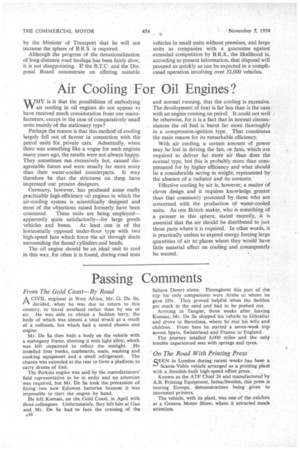Air Cooling For Oil Engines?
Page 32

If you've noticed an error in this article please click here to report it so we can fix it.
WHY is it that the possibilities of embodying air cooling in oil engines do not appear to have received much consideration from our manufacturers, except in the case of comparatively small units mainly of the stationary type?
Perhaps the reason is that this method of 'cooling largely fell out of favour in connection with the petrol units for private cars. Admittedly, when there was something like a vogue for such engines many years ago, the results were not always happy. They sometimes ran excessively hot, caused disagreeable fumes and were usually far more noisy than their water-cooled counterparts. It may therefore be that the strictures on thetri have impressed our present designers.
Germany, however, has produced some really practicable high-efficiency oil engines in which the air-cooling system is scientifically designed and most of the objections raised formerly have been countered. These units are being employed— apparently quite satisfactorily—for large goods vehicles and buses. At least one is of the horizontally opposed under-floor type with two high-speed fans which force the air through ducts surrounding the finned cylinders and heads.
The oil engine should be an ideal unit to cool in this way, for often it is found, during road tests and normal running, that the cooling is excessive. The development of heat is far less than is the case with an engine running on petrol. It could not well be otherwise, for it is a fact that in normal circumstances the oil fuel is burnt far more thoroughly in a compression-ignition type. That constitutes the main reason for its remarkable efficiency.
With air cooling, a certain amount of power may be lost in driving the fan, or fans, which are required to deliver far more air than does the normal type, but this is probably more than compensated for by higher efficiency and what 'should be a considerable saving in weight, represented by the absence of a radiator and its contents.
Effective cooling by air is, however, a matter of clever design and it requires knowledge greater than that commonly possessed by those who are concerned with the production of water-cooled units. As one British maker, who is something of a pioneer in this sphere, stated recently, it is essential that the air should be distributed to just those parts where it is required. In other words, it is practically useless to expend_ energy forcing large quantities of air to places where they would have little material effect on cooling and consequently be wasted.




















































































































